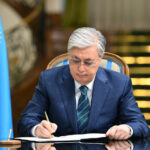The renaming of Astana Airport to Nur-Sultan raised eyebrows due to its perplexing three-letter code: NQZ. Not only is it hard to decipher, but it also prompts questions about the necessity of changing the airport’s name in the first place.
Prominent economist Almas Chukin decided to unravel the mystery behind the unusual code assigned to Astana Airport. This curious story unfolded after a brief investigation into a highly technical matter.
International organizations overseeing passenger aviation allocate three-letter designations, known as IDs, to airports. With numerous cities and even more airports worldwide, there’s a shortage of unique combinations, leading to occasional conflicts.
For instance, when Turkey built a new international airport, it adopted the IST code previously used by the older Istanbul airport. This transition made sense and retained the city’s identity.
In Asia, the abbreviations for airports are often quite straightforward. The airport in Tashkent is simply TAS, and it’s easy to guess the origin of ASB for Ashgabat and DYU for Dushanbe. FRU for Bishkek, Kyrgyzstan, likely stems from the city’s historical name.
However, the NQZ code for Astana Airport appears to be a genuine perplexity. In just two short years since Astana became Nur-Sultan, officials reached out to the International Air Transport Association (IATA) to obtain this three-letter code. A quick look at the list reveals that NUR belongs to a small airport in Nullabor, Australia, while NAZ is associated with the nearly forgotten Nana Airport in the Solomon Islands. The result is a peculiar hybrid, resembling N’QueZet.
The previous code, TSE, which served the old Astana well, was more straightforward as Tselinograd. If there is another change in the future, options like AST and ASA are already taken. A creative alternative could be AKZ, with the hope of establishing a distinctive and memorable identity for Kazakhstan’s aviation industry.









